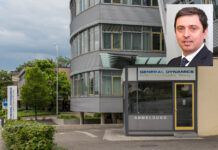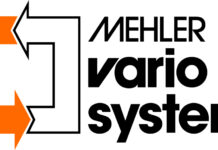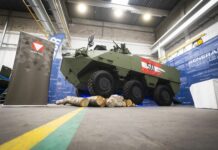Mobility, both in logistics and on the battlefield, is an indispensable prerequisite for the defence and effectiveness of armed forces. The company General Dynamics European Land Systems-Bridge Systems GmbH (GDELS-Bridge Systems) has made it its business to make significant contributions to supporting mobility in the armed forces. In this interview, the company’s managing director, Dr Christian Kauth, talks about capabilities, requirements and perspectives.
ESD: What is the importance of military bridge systems for the mobility of armed forces? Why are they needed?
Dr Kauth: That is quite easy to answer if you consider that the self-sufficient obstacle crossing capability of a military vehicle ends at three metres at the most. This type of obstacle is widespread. This also includes irrigation ditches on agricultural land. Likewise, existing bridge infrastructure is very often one of the first targets, especially of defending forces, to stop an advance.
ESD: Against this background, are there any insights or new findings for you that should be mentioned in connection with the current war in Ukraine?
Dr Kauth: At the beginning of the attacks, it was the Ukrainians themselves who destroyed the existing bridge infrastructure in order to stop the Russian advances. Since then, one has seen repeated attempts by Russian forces to move its forces over water obstacles, almost all of which have been unsuccessful so far, and most recently also ended in a major disaster for Russian forces when an attempt was made to build a pontoon bridge of about 80 metres over the Donets River. In the attack movement, the decisive factor is speed and good planning with air and artillery support. According to initial information, the bridge-building took place in the most obvious place and the construction was very slow, which may be due to the quality of the equipment used as well as the level of training. In addition, the aforementioned necessary support was lacking. Another factor may have been the insufficient quantity of bridge equipment. When you have too little, you become predictable about where you can cross a body of water, and apparently the Ukrainian forces then had these places well in view and could then cover them with artillery fire. A bridge is always a bottleneck where everything gathers, with a high concentration of vehicles and soldiers. The destruction was correspondingly significant.
ESD: How do you assess the current equipment status of the German Bundeswehr and NATO with military bridge equipment?
Dr Kauth: Without going into detail now – one should not make it too easy for the potential opponent and point out his weaknesses or the extent – the equipment is more than insufficient. Not in terms of the quality of the material, but rather the quantity. The fact that the crossing of the Vistula during Exercise ANAKONDA 2016 with two bridge crossings required that a large part of the heavy floating bridge capacity available in NATO was pooled says a lot about this equipment gap. Unfortunately, after the end of the Cold War, the procurement efforts for bridging systems were always lower in priority, also because they did not play a significant operational role in the past conflicts in which the Allies were involved.
ESD: Do you see cooperation within NATO, such as the German-British Engineer Battalion, as a model for the future? What impact does this have on your business?
Dr Kauth: This is partly a rediscovery of the past. The M3 amphibious vehicle was already specified and procured jointly by Germany and the UK. Now they have gone one step further and have also merged the associations. These things naturally promote and demand interoperability, also when it comes to the procurement of new systems, and have a positive effect on costs. And what should also be considered is that because we are in principle the last remaining system house that is able to design, develop and manufacture a new bridge and also support it in use, it naturally makes sense to specify and procure things together in order to make optimal use of the industrial capacities. Since we have not lost a floating bridge competition as a contender for more than 20 years, we have now created a de facto standard for heavy floating bridges among the allies with the Improved Ribbon Bridge (IRB) and the amphibious M3. Even without being required to do so, we have always focused on the interoperability of the equipment, not only within a product series, but also of the products in relation to each other and also to the predecessor systems that are still in use in individual countries.
ESD: How many BIBER (BEAVER) bridges are currently in use, both in the Bundeswehr and internationally? Since when and how has the bridge proven itself overall so far? Perhaps there are examples you can mention.
Dr Kauth: How many are still in use is difficult to quantify, because the BIBER was a very successful product. We have produced more than 300 bridges since 1972, and most of them are still in use, even if not by the first customer who received them, but in some cases now also in third-party applications via country levies. The bridge has therefore been used successfully for 50 years. A recent example of this also shows the potential of the product: The Estonians bought bridges from Dutch surplus stocks, and we overhauled them in a factory overhaul and recertified them to MLC 80. The product was developed at a time when we did not yet have mature calculation methods, which means that at that time we worked with significantly more safety margins, and this enables us today to raise the bridge far above the performance level specified at that time. This means that we know the structure very well, and when we receive a bridge, we know exactly where we need to look and what we need to repair, so that we can immediately recertify the bridge afterwards. This is an attractive way to close the existing quantitative gap, at least temporarily.
ESD: Is such an upgrade in the form of a post-certification, which obviously does not actually involve physical changes to the bridge, also planned for the Bundeswehr with regard to MLC 80? Is there a timetable for this? What would be the financial requirements?
Dr Kauth: We are not aware of any plans to carry this out for the Bundeswehr. We have worked out the concepts. No additional budget is required because it is part of the normal factory maintenance that the product is still undergoing and will continue to undergo in the next few years.
ESD: And are there any plans or proposals regarding a successor to the BIBER?
Dr Kauth: Yes, from what I just said, that the BIBER had very large reserves, it is not really necessary to change major parts of the design of the bridge, so we are thinking more about new concepts for carrier vehicles here and are also working on how, for example, the 22-metre bridge can be moved by a standard 8×8 truck. The bridge itself is more than sufficient for today’s and also future challenges and has, I think, also proven itself many times over the last 50 years, so the discussion is primarily focussed on the carrier vehicle.
ESD: The bridges of GDELS-Bridge Systems are made of aluminium. What are the advantages of aluminium as a material for military bridge equipment and where are the possible limitations?
Dr Kauth: Let me describe it like this: Aluminium is the best combination of the disadvantages of materials. Various things have to be taken into account in the development: the weight, the strength, the ability to diagnose damage, but also the maintainability and finally, of course, the costs in procurement and operation. Of all materials, aluminium represents the least bad compromise, so to speak. For every single characteristic, you will find materials that are better than aluminium, but so much worse in the other areas that we believe aluminium will remain the material of choice today and in the near future when it comes to mobile military bridge systems.
ESD: You have also built bridges from other materials?
Dr Kauth: Yes, we re-evaluate it over and over again. We are actually constantly trying to get rid of what we are good at, and that is aluminium and the welding of aluminium, because it is quite an expensive technology and production method. Every few years we try to approach new materials, whether it’s composites – we have even worked with magnesium, and of course with new steels. We approach it anew every few years, but we always come to the same conclusion: aluminium is the best.
ESD: At the Eurosatory exhibition this year, you presented the HYDRA system for the first time, as far as we know. The term “dual use” is used in this context. Can you explain that a little?
Dr Kauth: Well, we only presented HYDRA digitally at Eurosatory. Because of its dual-use character, the focus was actually on another trade fair that took place a week later, namely the world’s largest disaster control trade fair, Interschutz. Dual-use because the requirements of the disaster control forces for a floating bridge/ferry device are quite similar to those of the military, with a few compromises, which are ultimately decisive for the cost and complexity of the device. On the other hand, the fact is that this HYDRA product, which we developed primarily for civilian use, is very well suited as a floating bridge system for medium forces up to MLC 50 with a few modifications. In most countries where the armed forces also have the task of disaster control, it is in principle a product that we consider dual-use. In Germany, we have a stronger organisational separation of these tasks.
ESD: A question about the situation of the company. How is GDELS-Bridge Systems doing economically at the moment? What is the importance of Germany as a location for GDELS? Can you break down your turnover by region?
Dr Kauth: We have no reason to complain at the moment. We won a big competition in South Korea last year, and we also recently signed a contract with Sweden for the delivery of M3s and additional IRBs, which, together with winning the competition for the German Medium Protected Ambulance – that’s another area we are in – puts us in a pretty good position. Compared to previous years, where we had to fight our way through a cycle of very low demand for bridge systems, we notice that these are coming more into focus in some countries and we expect to be quite busy in the next few years as well. As the German location of General Dynamics, and especially of the European group, we are also in a position to offer the entire land system portfolio of the group in Germany, free of ITAR. Of course, this also includes the corresponding creation of value in Germany, including user support by German specialists.
ESD: Last question: You yourself are a doctor and hold a PhD inBiology. How did you deal with the challenges of the pandemic?
Dr Kauth: In January 2020, I was in South Korea for negotiations, and that was in the week when the first cases of the infection, which had previously been confined to China, also appeared in Korea. When the first cases in Germany appeared a short time later and I had read the first specialist articles about the virus, it quickly became clear to me that something big was coming. We reacted very quickly and implemented many measures that were later introduced throughout Germany very early on, so that we did not have any closures or interruptions of activities here at the site and could be available to our customers at all times. Now in the last Omicron wave, despite a high vaccination rate of over 90 per cent, it did hit us a bit, but not to an alarming degree. We had already introduced things like home office or mobile working before, so we were able to adapt quite quickly to doing this on a somewhat larger scale, so that overall, we got through quite well.
The interview was conducted by Jürgen Hensel.












